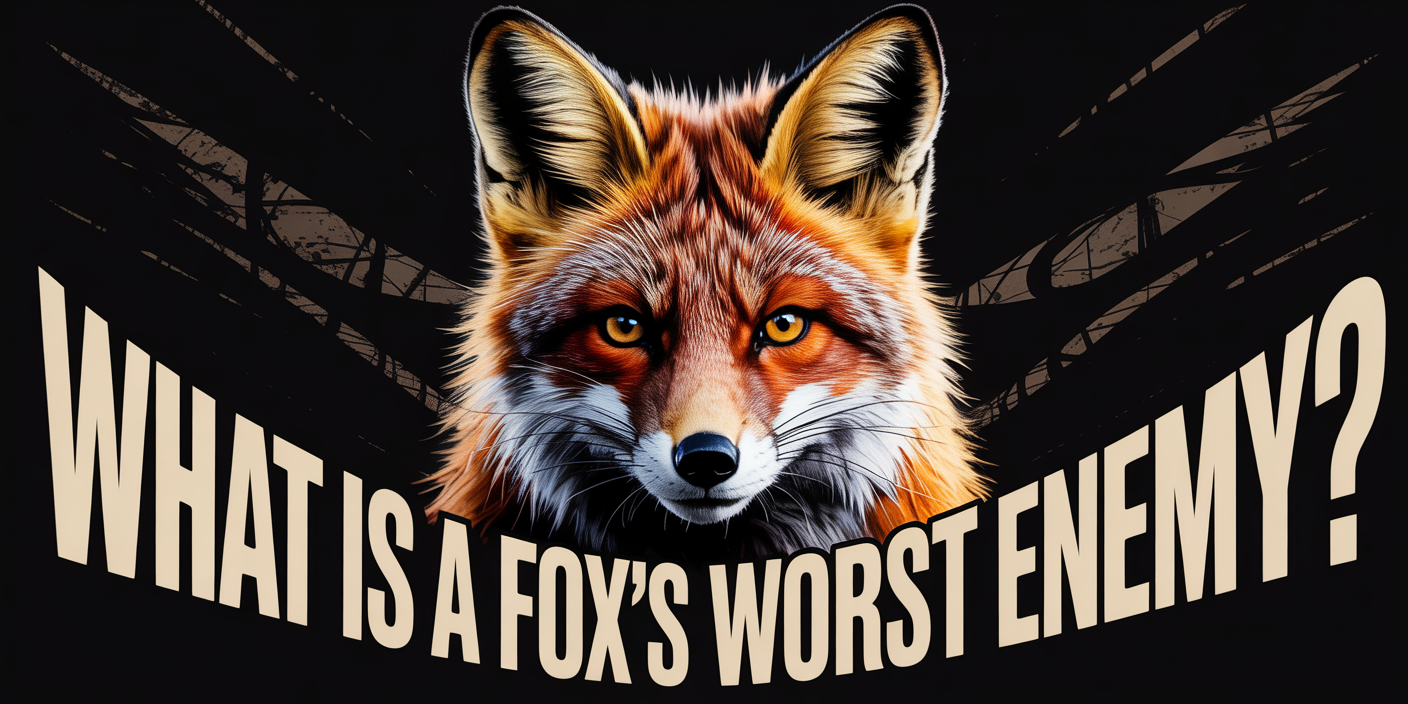“A fox’s worst enemy is often the coyote, as they compete for territory and food, making them direct rivals. Humans also pose a significant threat through urban development, hunting, and road mortality, further endangering fox populations.”
Foxes are a fascinating and elusive part of the wildlife in Dallas, TX, often seen darting through urban parks or silently roaming suburban neighborhoods. These cunning creatures play an important role in local ecosystems, controlling small mammal populations and even aiding in seed dispersal. However, despite their adaptability, foxes face numerous threats from other animals and humans alike. Understanding the natural enemies of a fox is essential for both wildlife enthusiasts and those involved in managing urban wildlife populations.
In Dallas, foxes are not only up against natural predators like coyotes and larger carnivores, but they also contend with the increasing dangers posed by human activities. Urban expansion and road traffic are some of the most direct threats foxes encounter, disrupting their habitats and often leading to fatal encounters. This post explores the various enemies of the fox, from fierce competitors to diseases, and highlights how humans can help mitigate these risks while ensuring a healthy balance in local ecosystems.
Learn more: Will animal control get rid of foxes?
1. Predators of Foxes
Foxes face a variety of natural predators that threaten their survival. These predators can range from larger carnivores to domestic pets, each posing unique risks.
Coyotes
Coyotes are one of the biggest natural enemies of foxes. They often compete for territory and food, and in urban and suburban areas like Dallas, coyotes may drive foxes from their habitats or even kill them in territorial disputes. The competition for resources such as small mammals and birds makes coyotes a significant threat to fox populations.
Wolves
Although less common in urban areas like Dallas, wolves historically prey on foxes, particularly when both species share overlapping territories. While the wolf population is currently limited, wolves still pose a threat in certain regions where they are more prevalent. In areas with higher wolf populations, foxes must be cautious and avoid encroaching on their territories.
Domestic Dogs
Domestic dogs, particularly those that are allowed to roam freely, can also pose a risk to foxes. When foxes venture into urban or suburban areas, where pets may be roaming off-leash, they face the danger of being attacked by dogs. This risk increases in populated areas where foxes might cross paths with household pets.
2. Humans: A Direct Threat
While natural predators are a significant concern for foxes, humans pose some of the most direct and damaging threats to their survival in Dallas. As urban areas expand, foxes are increasingly forced into smaller, more dangerous spaces, often leading them into direct conflict with human infrastructure like roads, buildings, and populated neighborhoods.
This urbanization results in habitat loss, which forces foxes to navigate risky environments where they are more likely to encounter dangers such as traffic. Road mortality is one of the most common threats, as foxes, in search of food, venture into areas heavily trafficked by vehicles, making them prone to fatal accidents.
Furthermore, foxes are sometimes targeted by hunters and trappers for their fur or as part of wildlife control efforts. While hunting and trapping are less common in urban areas, these practices still occur in surrounding rural regions and can further threaten fox populations. Additionally, some people may view foxes as nuisances, leading to trapping and removal efforts that directly harm the species. This combination of urban expansion, human intervention, and road hazards makes humans one of the fox’s worst enemies.
3. Natural Disease Threats
Foxes face several natural diseases that pose significant threats to their survival, weakening their health and making them more vulnerable to predators. These diseases include:
- Rabies: A viral disease that can be fatal for foxes, rabies is typically transmitted through bites from infected animals. Infected foxes may show neurological symptoms such as disorientation, increasing their likelihood of being killed by predators or vehicles.
- Mange: Caused by parasitic mites, mange leads to hair loss, skin irritation, and a weakened immune system. Foxes suffering from mange are more susceptible to infections, malnutrition, and predation due to their reduced ability to survive in the wild.
- Canine Distemper: This disease, primarily affecting dogs and other carnivores, can also infect foxes. It leads to neurological damage and makes the fox more vulnerable to other threats, including predators. Distemper outbreaks can significantly impact fox populations.
4. Competition for Food
In addition to natural predators and diseases, foxes also face competition for food, which can be a significant challenge to their survival. This competition often comes from other wildlife and even scavengers, making it harder for foxes to find enough resources to thrive.
- Competition from Larger Predators: Larger animals like bobcats and hawks often outcompete foxes for food sources such as small mammals, birds, and insects. These predators are better equipped to hunt and dominate food sources, leaving foxes with fewer options.
- Scavengers: Raccoons and opossums are examples of scavengers that may outmaneuver foxes in the search for food. As omnivores, these animals are highly adaptable and may take advantage of food sources that foxes rely on, such as garbage, leftover prey, or crops.
Foxes are resourceful and can adapt to a variety of food sources, but when their competitors dominate the available resources, it becomes even harder for them to sustain themselves, further putting their populations at risk.
5. How Foxes Protect Themselves
Despite facing numerous threats, foxes have developed several survival strategies to protect themselves from predators and other dangers. One of their key defenses is their speed and agility. Foxes are incredibly fast, able to outrun many of their predators, including coyotes and domestic dogs. Their quick reflexes and ability to change direction on a dime make it difficult for predators to catch them. Additionally, camouflage and denning play a crucial role in their survival. Foxes’ fur coats blend seamlessly into their natural surroundings, allowing them to remain hidden from larger predators. They also seek refuge in dens—burrows or abandoned structures—which provide shelter and protection from both environmental factors and threats.
Another significant survival tactic is territorial behavior. Foxes are highly territorial and will defend their home turf from invaders. They mark their territory with scent markings and vocalizations to signal to other animals, particularly larger predators, that the area is already occupied. This helps to reduce conflicts and ensures that they can safely navigate their environment. Through these adaptive strategies, foxes are able to maintain their populations despite the various challenges they face.
6. Impact on Local Ecosystems and How AAAC Can Help
Foxes, like all wildlife, play an essential role in maintaining the balance of local ecosystems. As predators, they help control populations of small mammals, insects, and even plants, contributing to the overall health of the environment. However, when faced with numerous threats—from predators and disease to human interference—fox populations can decline, which may disrupt these ecological processes. Managing the interactions between humans and wildlife is crucial to preserving these natural balances.
AAAC Wildlife Removal is committed to providing safe, humane solutions for managing fox populations and reducing conflicts between humans and wildlife. By understanding the dangers foxes face and promoting responsible wildlife management, we can help ensure that foxes continue to thrive in their natural habitats. If you encounter a fox in your area or have concerns about potential wildlife conflicts, AAAC Wildlife Removal is here to offer professional assistance, ensuring both human safety and the well-being of local wildlife.
Conclusion
In Dallas, foxes face a variety of threats from both natural predators and human activities. Coyotes, domestic dogs, and even humans themselves can pose significant risks to their survival. Diseases like rabies and mange further weaken fox populations, while competition for food from larger predators and scavengers makes survival even harder. Despite these challenges, foxes have developed remarkable survival strategies, including speed, agility, camouflage, and territorial behavior, that help them navigate these dangers.
It’s crucial for us to understand the role these animals play in our local ecosystems and take steps to ensure their safety. If you encounter a fox or other wildlife in your area, AAAC Wildlife Removal is here to provide expert advice and humane fox removal services. Protecting both human and wildlife populations requires careful management, and with AAAC’s help, we can ensure a peaceful coexistence for all.




